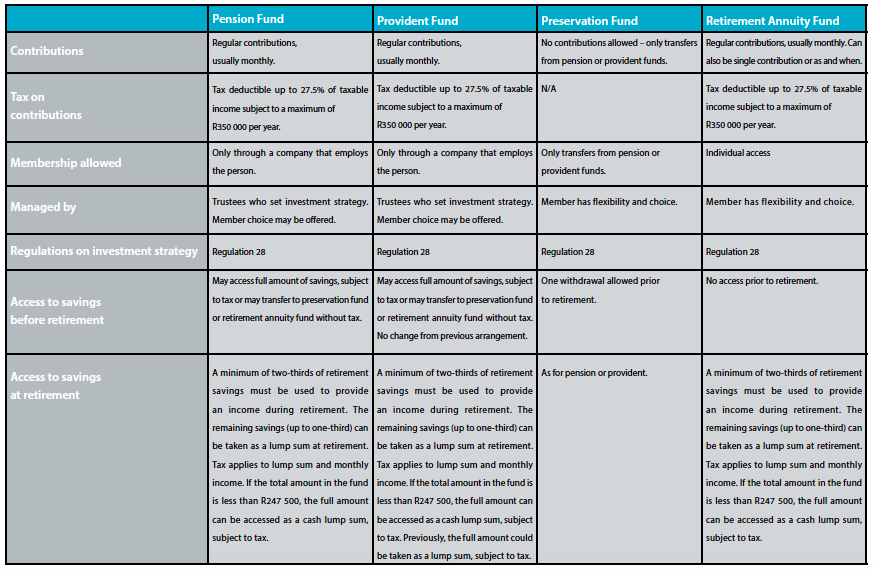On average, people with some form of retirement savings can expect to receive a retirement income of just over a quarter of their salary at retirement, which is unlikely to sustain them throughout their post-work lives. A financially secure retirement means a person needs to replace their salary with a roughly equivalent pension.
The so-called income replacement ratio for the average worker ideally needs to be a minimum of 75% meaning their monthly pension before tax should be at least 75% of their monthly salary before tax. For example, if an employee’s last salary was R80 000 a month, a retirement income of R60 000 would be needed to maintain their standard of living. Why less? It is because there is no longer an amount being set aside for retirement, there are also some tax breaks and some costs like paying off a home and supporting children’s education are hopefully lower or completely absent.
To make it easier for people to save adequately for retirement, government introduced the Taxation Laws Amendment Act aimed at simplifying the landscape by aligning the various retirement savings vehicles and their tax treatment. The next step in this process came into effect on 1 March 2021. It aims to ensure that provident fund members are treated the same as pension and retirement annuity fund members.
Provident fund members could previously take all their savings as a lump sum at retirement (less any taxes). From 1 March, like for pension funds and retirement annuity funds, the capital amount at retirement must be used to provide the member with a monthly income, not just a once-off lump sum. While this does reduce the flexibility that members have in relation to how they use their savings, the reality is that all people have a need for a monthly income during retirement and not a lump sum at a random retirement date.
These changes make it easier for South Africans to understand how to save for retirement; the retirement savings vehicles (or funds) available to them; what tax breaks are offered on retirement savings and to ensure that they use their savings wisely to provide for their needs in retirement.
How retirement funds differ
The act brings much-needed harmonisation, and hence simplification, of retirement funds – which include pension, provident, preservation and retirement annuity funds. While similar, it is important to understand how they differ.

How the new Act impacts on retirement savings
Under the new legislation, provident funds now have the same rules as pension funds. It is important to note, though, that members’ existing rights are not affected. This means that the old rules will apply to the savings accumulated up to the effective date and for older members even their continuing savings will still be eligible for the old rules.
Those aged 55 and older on 1 March 2021 will not be affected as the full value of their retirement savings will be paid as a lump sum upon retirement, provided they remain in the same fund. If they change their retirement fund after 1 March 2021, they will be treated as a new member meaning their future contributions will be eligible for the new rules.
Those younger than 55 on 1 March 2021 will have two separate pots of retirement savings. The first pot includes all retirement savings up to 1 March 2021 and all the future investment growth on those savings. All the savings in this pot will be subject to the old rules so will be accessible as a lump sum when retirement age is reached.
All contributions paid into the retirement fund after 1 March 2021 will go into a separate savings pot. This pot, including the investment growth on it, will be subject to the new rules applied at retirement. That means that retirees can take up to one-third of this pot as a lump sum and the rest will be paid as a monthly pension. However, if at retirement the new savings pot is less than R247 500, then the full 100% can be taken as a lump sum.
None of these changes impact provident fund members who have resigned or who are dismissed or retrenched. They can still take their full retirement savings in cash and any amount withdrawn is taxed. Of course, it is not advisable to take retirement savings and spend them when changing jobs as this hampers the ability to save enough for retirement.
Similarly, those who wish to use their retirement funds to emigrate should carefully consider their options.
Changes to phase out emigration for exchange control purposes mean that members of retirement annuities and preservation funds can make a full cash withdrawal, but only if they haven’t lived in South Africa for three years and have non-resident status with SARS for three years. This means that they should not plan to use their retirement savings to finance their initial setup in another country, although they will be able to move their savings after the three-year period.
The principles of planning for retirement
Despite the clear advantages of the amendments, they do little to impact how South Africans should plan for their retirement. The recommended income replacement ratio of around 75% to maintain standard of living during retirement is a ballpark figure. It is dependent on individual circumstances such as income level, debt levels, other savings outside of retirement vehicles and the educational needs of any children.

While an adequate retirement savings plan is a necessity, an overall financial wellness plan that includes adopting more disciplined savings habits, should not be neglected. South Africans’ low household savings rates and high debt-to-income ratio would not have been helped by the financial shock delivered by Covid-19.
Savings create resilience to deal with a crisis, whereas debt makes households much more vulnerable. The added benefit of having cash savings available is that they can be used to invest in markets when they reach historical lows – a good long-term strategy.
Not having savings outside of retirement funds results in people raiding retirement savings in times of crisis, like many have done over the past year. Although this may be a necessity, it makes it unlikely that savings will see investors through their retirement.
It is therefore essential to have a plan to replenish those savings by making additional contributions as soon as one’s financial situation improves.












